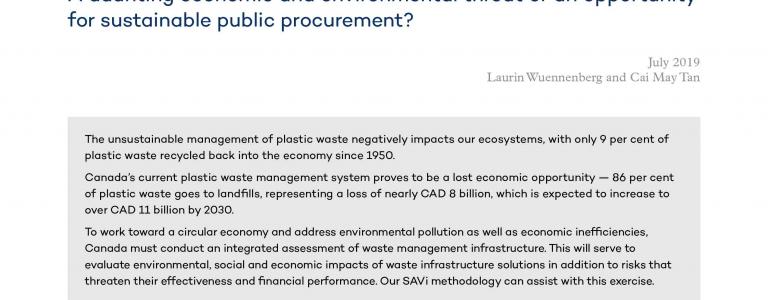Plastic Waste in Canada: A daunting economic and environmental threat or an opportunity for sustainable public procurement?
This commentary explores how sustainable public procurement can play a crucial role in advancing environmental and economic sustainable development in Canada's waste sector.
Key Messages
- The unsustainable management of plastic waste negatively impacts our ecosystems, with only 9 per cent of plastic waste recycled back into the economy since 1950.
- Canada’s current plastic waste management system proves to be a lost economic opportunity—86 per cent of plastic waste goes to landfills, representing a loss of nearly CAD 8 billion, which is expected to increase to over CAD 11 billion by 2030.
- To work toward a circular economy and address environmental pollution as well as economic inefficiencies, Canada must conduct an integrated assessment of waste management infrastructure.
Canada is facing a growing plastic waste challenge, and calls to action on plastic waste reduction have gained traction over the past years.
We use plastics every day: it is found in our electronics, we package our food in it, construction elements are born from it, children’s toys are built with it, and more.
However, currently plastics are not kept in closed-loop systems. This means most plastic material produced ends up in landfills after its designated lifetime. Since 1950, a mere 9 per cent of plastic waste was recycled back into the economy, whereas 12 per cent had been incinerated and 79 per cent discarded. Plastic waste management thus far has been unsustainable, and the world faces a growing problem.
Our commentary explores how sustainable public procurement can play a crucial role in advancing environmental and economic sustainable development in Canada's waste sector.
You might also be interested in
Funding for Canadian Prairies’ water infrastructure urgently needed, but nature offers innovative solutions—new report
The Canadian Prairie provinces’ water infrastructure is aging and depreciating at an alarming rate. However, natural infrastructure can offer a practical and cost-effective solution when scaled up and adopted across all levels of government.
The State of Play of Natural Infrastructure on the Canadian Prairies
We sat down with key experts across the region and reviewed the latest literature to determine how we take natural infrastructure from novel to normal on Canada's Prairies.
Nanosilver: What action needs to be taken to protect Canadians from this emerging contaminant?
We explore exactly why we need to be worried about nanosilver and what Canada needs to do about it to protect our fresh water.
Our Fresh Water Is Seeing More Plastic Litter due to COVID-19: Here’s what Canada should do about it
As part of the changes to our daily life brought about by COVID-19, Canadians’ reliance on certain types of single-use plastics has increased. We explore that impact on fresh water, and explain what we need to do about it.
